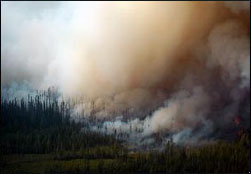Climate change, human activity and wildfires
 Study published in Nature Geoscience in latest September edition says that climate change has been the main driver of global biomass burning for the past two millennia.
Large, well-documented wildfires have recently generated worldwide attention, and raised concerns about the impacts of humans and climate change on wildfire regimes. However, comparatively little is known about the patterns and driving forces of global fire activity before the twentieth century. Researchers have compiled sedimentary charcoal records spanning six continents to document trends in both natural and anthropogenic biomass burning for the past two millennia and found that global biomass burning declined from AD 1 to 1750, before rising sharply between 1750 and 1870. Global burning then declined abruptly after 1870. The early decline in biomass burning occurred in concert with a global cooling trend and despite a rise in the human population. They suggested the subsequent rise is linked to increasing human influences, such as population growth and land-use changes. Their compilation suggests that the final decline occurred despite increasing air temperatures and population and attributed this reduction in the amount of biomass burned over the past 150 years to the global expansion of intensive grazing, agriculture and fire management.
Study published in Nature Geoscience in latest September edition says that climate change has been the main driver of global biomass burning for the past two millennia.
Large, well-documented wildfires have recently generated worldwide attention, and raised concerns about the impacts of humans and climate change on wildfire regimes. However, comparatively little is known about the patterns and driving forces of global fire activity before the twentieth century. Researchers have compiled sedimentary charcoal records spanning six continents to document trends in both natural and anthropogenic biomass burning for the past two millennia and found that global biomass burning declined from AD 1 to 1750, before rising sharply between 1750 and 1870. Global burning then declined abruptly after 1870. The early decline in biomass burning occurred in concert with a global cooling trend and despite a rise in the human population. They suggested the subsequent rise is linked to increasing human influences, such as population growth and land-use changes. Their compilation suggests that the final decline occurred despite increasing air temperatures and population and attributed this reduction in the amount of biomass burned over the past 150 years to the global expansion of intensive grazing, agriculture and fire management.
Related Content
- World Heritage forests: carbon sinks under pressure
- No time to lose, says Sunita Narain on the new IPCC report
- Control of the multimillennial wildfire size in boreal North America by spring climatic conditions
- Long-term perspective on wildfires in the western USA
- Driving forces of global wildfires over the past millennium and the forthcoming century
